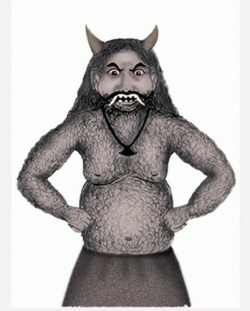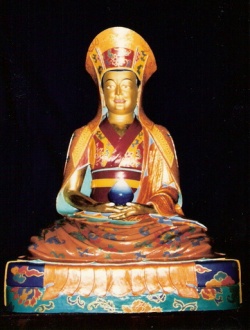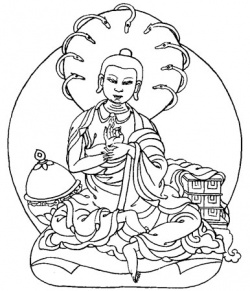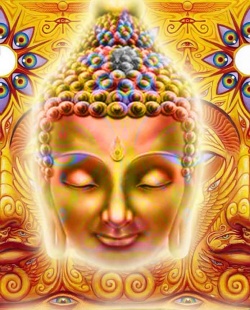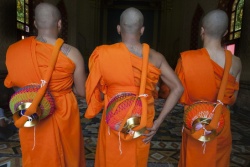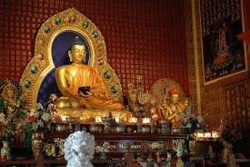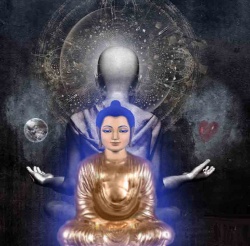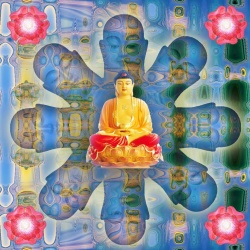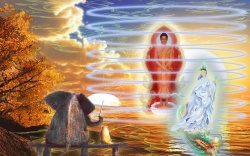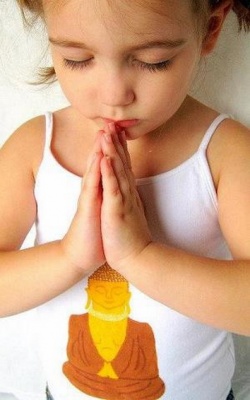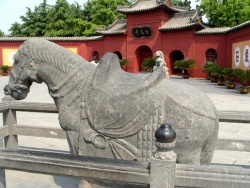Rakshasa
- See also :
- See also :
Human-like beings, usually depicted as being very evil, even man-eaters.
A Rakshasa is said to be a mythological humanoid being or unrighteous spirit in Hinduism.
As mythology made its way into other religions, the rakshasa was later incorporated into Buddhism.
Rakshasas are also called man-eaters (Nri-chakshas, Kravyads). A female rakshasa is called a Rakshasi, and a female Rakshasa in human form is a Manushya-Rakshasi. Often Asura and Rakshasa are interchangeably used.
Hindu lore
Vedic/Puranic stories
It is said that Rakshasas were created from the breath of Brahma when he was asleep at the end of the Satya Yuga.
As soon as they were created, they were so filled with bloodlust that they started eating Brahma himself.
Brahma shouted "Rakshama!" (Sanskrit for "protect me!") and Vishnu came to his aid, banishing to Earth all Rakshasas (thus named after Brahma's cry for help).
Their literary origins can be traced to Vedic sources through Hymn 87 of the tenth mandala of the Rig Veda. Here they are classified amongst the Yatudhanas, demonic creatures who consume the flesh of the humans.
The tracing back to Kashyapa is not necessarily a later edit, but is not mentioned in the dense Hymns of the Vedas because of poetic choice.
The knowledge of the Rakshasa lineage traceable to Kashyapa may have been known at the time of the compilation of the Vedas, but lineages are altogether foreign from the style of the Vedas and thus would have appeared out of place. That is why the Puranans and Epics elaborate on lineages, but Vedas do not.
Kashyapa was married to the thirteen daughters of Daksha, among them were Aditi, Diti and Danu.
- His sons with Danu are the Danavas
- His sons with Diti are the Daityas
- His sons with Aditi are the Adityas, who considered Devas and are also called Suras.
Rakshasa were most often depicted as ugly, fierce-looking and enormous creatures and with two fangs protruding down from the top of the mouth as well as sharp, claw-like fingernails.
They are shown as being mean, growling like beasts and as insatiable cannibals who could smell the scent of flesh.
Some of the more ferocious ones were shown with flaming red eyes and hair, drinking blood with their palms or from a human skull (similar to vampires in later Western mythology).
Generally they could fly, vanish, and had Maya (magical powers of illusion), which enabled them to change size at will and assume the form of any creature.
In Hindu epics
In the world of the Ramayana and Mahabharata, Rakshasas were a populous race of supernatural humanoids.
There were both good and evil rakshasas, and as warriors they fought alongside the armies of both good and evil.
They were powerful warriors, expert magicians and illusionists.
As shape-changers, they could assume various physical forms, and it was not always clear whether they had a true or natural form.[citation needed]
As illusionists, they were capable of creating appearances which were real to those who believed in them or who failed to dispel them.
Some of the rakshasas were said to be man-eaters, and made their gleeful appearance when the slaughter on the battlefield was at its worst. Occasionally they serve as rank-and-file soldiers in the service of one or the other warlord.
Aside from its treatment of unnamed rank-and-file Rakshasas, the epic tells the stories of certain members of the race who rose to prominence, some of them as heroes, most of them as villains.
In the Ramayana
The Battle of Lanka pitted an army of Rakshasas under Ravana against an army of Vanaras or monkeys under Rama and Sugriva.
- Ravana, a Rakshasa with ten heads, was the King of the Rakshasas and the mortal enemy of Rama, the hero of the Ramayana.
In the Ramayana (Book III: Vana Parva, Section 271 ff.), the Sage Markandeya recounts the story of how Ravana kidnapped Rama's wife Sita and whisked her off to his stronghold Lanka, and how Rama, aided by the monkey King Sugriva and his army of monkeys, laid siege to Lanka, slew Ravana, and rescued Sita.
- Vibhishana, Ravana's younger brother, was a rare good-hearted Rakshasa;
he was beautiful, pious and assiduous in his religious observances. When Brahma granted him a boon, he asked never to swerve from the path of righteousness and to be illumined by divine knowledge (Book III, Vana Parva:
Section 273.) Vibhishana joined Rama in his campaign against Ravana, and helped Rama's army to cross the ocean into Lanka (Section 281).
When invisible Rakshasas infiltrated Rama's camp, Vibhishana caused them to become visible, and Rama's monkey soldiers destroyed them (Section 283).
After Rama's final victory over Ravana, the loyal Vibhishana was made king of Lanka (Section 289).
- Kumbhakarna was another brother of Ravana.
A fearsome warrior and master of illusion, he slept through most of the Battle of Lanka (having long before requested and received a gift of long-lasting sleep from Brahma), but arose and took the field when Ravana awakened him with alarming news about the progression of the conflict.
Upon marching out of the city, Kumbhakarna was immediately swarmed by Rama's monkeys, causing him only to laugh and to wreak great mayhem among them.
When the monkey king Sugriva attacked, Kumbhakarna grabbed him and started to drag him off.
It was at that point that Rama and his brother Lakshmana used arrows and a secret Brahmastra ("Brahma's weapon") to kill Kumbhakarna, dropping the Rakshasa like a huge tree cleft in twain by a thunderbolt. (Ramayana, Book III: Vana Parva, Section 285.)
Other Rakshasa that appear in the Ramayana include Kabandha, Tataka, Surpanakha, Maricha, Subahu, Khara, Indrajit, Prahasta, Akshayakumara, and Atikaya.
In the Mahabharata
The Pandava hero Bhima was the nemesis of forest-dwelling Rakshasas who dined on human travellers and terrorized human settlements.
The Mahabharata (Book I: Adi Parva, Section 154) describes him as a cruel cannibal with sharp, long teeth and prodigious strength.
When Hidimba saw the Pandavas sleeping in his forest, he decided to eat them. He made the mistake of sending his sister Hidimbi to reconnoiter the situation, and the damsel fell in love with the handsome Bhima, whom she warned of the danger.
Infuriated, Hidimba declared himself ready to kill not only the Pandavas but also his sister, but he was thwarted by the heroism of Bhima, who defeated and killed him in a duel.
Ghatotkacha, was the son of Bhima and Hidimbi.
His name refers to his round bald head with ghata meaning pot and utkacha meaning head in Sanskrit.
Ghatotkacha, when he was young, lived with his mother Hidimbi, when one day he had a fight with Abhimanyu, his cousin, without knowing that Abhimanyu was Arjuna's son.
Ghatotkacha is considered to be a loyal and humble figure. He made himself and his followers available to his father Bhima at any time; all Bhima had to do was to think of him and he would appear. Like his father, Ghatotkacha primarily fought with the mace.
His wife was Ahilawati and his son was Barbarika.
In the Mahabharata, Ghatotkacha was summoned by Bhima to fight on the Pandava side in the Kurukshetra War. Invoking his magical powers, he wrought great havoc in the Kaurava army. In particular after the death of Jayadratha, when the battle continued on past sunset, his powers were at their most effective (at night).
At this point in the battle, the Kaurava leader Duryodhana appealed to his best fighter, Karna, to kill Ghatotkacha as the whole Kaurava army was coming close to annihilation due to his ceaseless strikes from the air.
Karna possessed a divine weapon, Shakti, granted by the god Indra. It could be used only once, and Karna had been saving it to use on his arch-enemy, the best Pandava fighter, Arjuna.
Unable to refuse Duryodhana, Karna used the Shakti against Ghatotkacha, killing him. This is considered to be the turning point of the war.
After his death, the Pandava counselor Krishna smiled, as he considered the war to have been won for the Pandavas now that Karna no longer had a divine weapon to use in fighting Arjuna.
There is a temple in Manali, Himachal Pradesh, for Ghatotkacha near the Hidimba Devi Temple.
- Kamsa was the brother of Devaki. Kamsa was a cruel rakshasa who killed his sister's children because he thought that his death would be caused by one of them.
Vasudev, husband of Devaki was able to save one of her children. That child's name was Krishna.
- Bakasur was a cannibalistic forest-dwelling Rakshasa who terrorized the nearby human population by forcing them to take turns making him regular deliveries of food, including human victims.
Unfortunately for Bakasur, the Pandavas travelled into the area and took up residence with a local Brahmin whose turn had come up to make the delivery.
As the Brahmin and his family debated which one of them would have to be sacrificed, the rugged Bhima volunteered to take care of the matter.
Bhima went into the forest with the food delivery (consuming it on the way to annoy Bakasur) and engaged Bakasur in a ferocious wrestling match, which ended with Bhima breaking his opponent's back.
The human townspeople were amazed and grateful, and the local Rakshasas begged for mercy, which Bhima granted them on the condition that they give up cannibalism.
The Rakshasas agreed to the proposal, and soon acquired a reputation for being peaceful towards humans. (Book I: Adi Parva, Sections 159-166.)
He haunted the wood of Kamyaka, dining on human travellers.
Like his brother before him, Kirmira made the mistake of fighting the Pandav hero Bhim, who killed him with his bare hands (Book III: Varna Parva, Section 11).
- Jatasur was a cunning Rakshas who, disguised as a Brahmin, attempted to steal the Pandavas' weapons and to ravish their wife Draupadi.
Bhima arrived in time to intervene, and killed Jatasur in a duel. (Book III: Varna Parva, Section 156). Jatasur's son was Alamvush, who fought on the side of the Kauravas at Kurukshetra.
Rakshasas heroes fought on both sides in the Kurukshetra war.
- Ghatotkacha, a hero fighting on the side of the Pandavas, was the son of Bhima and the Rakshasa Hidimbi, the sister of a being slain by Bhima.
After performing many heroic deeds on the battlefield and fighting numerous duels with other great warriors (including the Rakshasa Alamvusha, the elephant-riding king Bhagadatta, and Aswatthaman, the son of Drona), Ghatotkacha was himself slain by the human hero Karna.
In order to defeat Ghatotkacha, Karna found himself compelled to use a one-time secret weapon that he had been intending to reserve for use against his bitter rival Arjuna.
When Arjuna defeated Karna in battle, it was in no small part because Karna had already expended his secret weapon. (Book VII: Drona Parva, Section 179.)
- Alamvusha was a Rakshasa skilled at fighting with both conventional weapons and the powers of illusion.
According to the Mahabharata, he fought on the side of the Kauravas. Arjuna defeated him in a duel (Book VII: Drona Parva, Section 167), as did Arjuna's son Abhimanyu (Book VI: Bhishma Parva, Section 101–102).
However, Alamvusha was able to kill Iravan, Arjuna's son by a Nāga princess Ulupi, when the Rakshasa used his powers of illusion to take on the form of Garuda.
Alamvusha was also defeated by Bhima (Book VII: Drona Parva, Section 107), and he was slain by above-mentioned Rakshasa Ghatotkacha (Book VII: Drona Parva, Section 108).
Rakshasas in Buddhist lore
Theravada Buddhist literature
In the Maha Samaya Sutta, the defeated antagonist of the Buddha, Mara also known as Namuci or the "Dark One" is described as a corrupted Asura whose army consisted of "Sensual passions, Discontent, Hunger and Thirst, Craving, Sloth and Drowsiness, Terror, Uncertainty, Hypocrisy and Stubbornness, Gains, Offerings, Fame and Status wrongly gained, and whoever would praise self and disparage others" (Sn 3.2 Padhana Sutta). The Asuras try to capture the devas and bind them. However, not all Asuras are Rakshasas.
The Alavaka Sutta (SN 10.12) of the Pali Canon details a story where the Buddha was harassed by a Rakshasa, who asked him to leave and then come back over and over.
The Buddha refused to leave, whereby the Rakshasa threatened to harm him if he could not answer his questions.
The rest of the sutra concerns the question and answer dialogue, and at the end, the demon is then convinced and becomes a follower of the Buddha.
Sri Lankan (Sinhala) ancestral legends refer to Yakshas as well.
One of Buddha's ten titles is "Sasta deva manusanam", or the teacher of gods and men.
Mahayana Buddhist literature
Ravana is mentioned in the famous Buddhist sutra, "Lankavatara Sutra" as paying homage to the Buddha.
Chapter 26 of the Lotus Sutra includes a dialogue between the Buddha and a group of Rakshasa daughters, who swear to uphold and protect the Lotus Sutra.
They also teach magical dharanis to protect followers who also uphold the sutra.
In The Lotus-Born: The Life Story of Padmasambhava, recorded by Yeshe Tsogyal, Padmasambhava receives the nickname of "Rakshasa Demon" during one of his wrathful conquests to subdue Buddhist heretics.
In Japanese tradition Rakshasas are known as Rasetsu (羅刹).
Artistic and folkloric depictions of Rakshasas
Depictions of Rakshasas at Angkor in Cambodia
The ten-headed Ravana is shown anchoring the line of Asuras.
- Likewise, a bas-relief at the 12th-century temple of Angkor Wat that depicts the churning has Ravana anchoring the line of Asuras that are pulling on the serpent's head.
It is speculated that one of the figures in the line of Devas participating in the churning by pulling on the serpent's tail is Ravana's brother Vibhishana.
- Likewise, a bas-relief at Angkor Wat shows a 20-armed Ravana shaking Mount Kailasa.
- The artists of Angkor also depicted the Battle of Lanka between the Rakshasas under the command of Ravana and the Vanaras or monkeys under the command of Rama and Sugriva.
- The 12th century Khmer temple Angkor Wat contains a dramatic depiction in bas-relief of the Battle of Lanka between Ravana's Rakshasas and Rama's monkeys.
Ravana himself is depicted with ten heads and twenty arms, mounted on a chariot drawn by creatures that look to be a mixture of horse, lion, and bird. Vibhishana is shown standing behind and aligned with Rama and his brother Lakshmana. Kumbhakarna, mounted on a chariot similar to that of Ravana, is shown fighting Sugriva.
- Likewise, the battle is depicted in a crude bas-relief at the 12th-century temple of Preah Khan.
Rakshasas in languages
In Indonesian and Malay, "raksasa" simply means "giant", "gigantic", or "huge and strong", or "monster" in colloquial usage.[10] Indonesian and Malay are very closely related languages with significant Sanskrit influence.
In Bengali, "rakhosh" is used as term for a person who eats incessantly and without burden.
This derivation also occurred in Malay and Indonesian as "rakus", which means "greedy".
References
- Freeman, Michael and Claude Jacques (2003). Ancient Angkor. Bangkok: River Books.
- Rovedo, Vittorio (1997). Khmer Mythology: Secrets of Angkor. New York: Weatherhill.
Further reading
- Pollock, Sheldon (1985/1986). Rakshasas and others, Indologica Taurinensia 13, 263-281
External links
- The Mahabharata of Vyasa translated from Sanskrit into English by Kisari Mohan Ganguli, online version
Source
A rakshasa (Sanskrit: रकषस, Rakṣasa; alternately, Raksasa or Rakshas) is a demon or unrighteous Spiritual being spirit in Hinduism.
Indian mythology
The Ramayana describes them as being created from Brahma's foot; elsewhere, they are descended from Pulastya, or from Khasa, or from Nirriti and Nirrita.
Many Rakshasa were particularly wicked humans in previous incarnations. Rakshasas are notorious for disturbing sacrifices, desecrating graves, harassing priests, possessing human beings, and so on.
Their fingernails are poisonous, and they feed on human flesh and spoiled Food.
They are shapechangers and magicians, and often appear in the forms of humans, dogs, and large birds.
Hanuman, during a visit to the rakshasas' home in Lanka, observed that the demons could come in any Form imaginable.
The great ten-headed demon Ravana, enemy of Rama, was king of the rakshasas.
His younger brother Vibhishana was a rare good-hearted rakshasa;
he was exiled by his brother the king, who was displeased by his behavior. Vibhishana later became an ally of Rama and a ruler in Lanka.
Other notable rakshasas include the guardian God Nairitya, who is associated with the southwest direction.
A female rakshasa is called a rakshasi, and a female rakshasa in human Form is a manusha-rakshasi.
The term has an etymology in common with the term rakṣa, meaning 'defender'.
Usage in the West
The term rakshasa has been used in western literature and culture. The following are some examples:
In Lord of Light
In Roger Zelazny's book Lord of Light the Rakshasa, there spelled "Rakasha", are a type of extraterrestrial beings consisting of "stable fields of energy".
The Rakasha were supposedly once material beings, but long ago used unspecified technology to move their Atman into energy fields.
This gave them the immortality, but "born of matter they do ever lust after the flesh" (p. 32).
Although it might seem rather foolish of the Rakasha to use highly advanced technology to abandon bodies and then find that they preferred having flesh after all, they have the Power to sometimes Demonic possession possess human bodies.
Since a mortal who inhabits a Body dies with it, unless he transfers his Atman into an unused Body, while a Rakasha can survive the destruction of it's resident Body, the Rakasha's choice does give them advantages that not making it would have lacked.
Their natural shape is that of a glowing flame, although they can briefly take nearly any shape they choose to.
In their normal shape they are capable of flying, seeing in all directions and surviving most attacks by material Weapons (although some compounds can repel them).
When inhabiting a human Body, they lose the Power to fly for unlimited distances and (presumably, as they never do so) to change shape, but gain the ability to enjoy Alcohol, good Food and sex.
They seem more Amorality amoral than intentionally Evil, normally lacking consciences.
One of their preferred pastimes is Gambling, and Gambling debts are the only promises that they can be relied upon to keep.
Gambling with Rakasha can lead either to Death or great Power, as the Rakasha can give powerful gifts but have little Desire for other material things than the Body of their fellow gambler.
The Rakasha seem to have no clear hierarchy, although they are led by a very old and powerful Rakasha called Taraka.
They also control several kinds of lesser energy beings, the only kind explicitly named being the "Fire elementals" (note that these resemble mobile thunderbolts more than classical, western Fire elementals).
In Dungeons & Dragons
In the role-playing game Dungeons & Dragons, the Rakshasa are a type of evil beings from the Alignment (role-playing games) lawful evil parts of the Outer Planes.
They are powerful Sorcerer (Dungeons & Dragons) sorcerers and, although they disdain physical fighting as ignoble, can be dangerous in close combat as well.
Two subtypes of Rakshasa, differing from the common Rakshasa exist: Ak'chazar Rakshasa and Naztharune Rakshasa.
Their natural shapes are relatively humanoid although they are clearly not human, as they have the heads of beasts -- usually tigers, but sometimes apes, crocodiles, mantises, or other creatures.
Their hands also look disturbing to most humans, as their palms are where the back of the hands would be in humans.
The Rakshasa are capable of hiding their disturbing appearance at any time, as they can choose any humanoid form at will. Rakshasa are solitary beings, although they do occasionally cooperate with each other.
Since Rakshasa are ambitious beings, as well as being solitary, sorcerous shapeshifters, they typically hold leading positions in whatever undertaking they are involved in. They are therefore typical Boss (video games) boss monsters.
The Ak'chazar have the heads of white tigers and are skinnier than common Rakshasa.
They are unusually powerful spellcasters, even for Rakshasa, and specialize in Necromancy necromantic magic.
To use their necromantic powers to their full potential the Ak'chazar often use graveyards or old battlefields as their headquarters.
When working on one of their dark schemes the Ak'chazar often let their undead do the physical work while they stay behind the scenes themselves.
The Naztharune have the heads of black tigers and are covered in black fur.
They have few magical powers but compensate by being strong fighters, specializing in assassination.
They lack most Rakshasa's need to be the leader of any organisation that they are part of, often working for other Rakshasa.
Rakshasa do not have a significant presence in most campaign setting campaign settings -- they may be present in the setting, but lack a great deal of influence.
In the Eberron campaign setting, however, rakshasa were once a major world power, but were defeated and forced into withdrawal from active participation in world events by the couatl couatls.
In other fiction
Although not particularly common in Western fiction, the short-lived 1974 television series Kolchak:
The Night Stalker (which influenced The X-Files) has an episode (Horror in the Heights) featuring a Rakshasa which is vulnerable to blessed crossbow bolts.
In the manga Fist of the North Star, the character Shachi is referred to as "Rakshasa, the Asura-devouring beast".
In the Exile (computer game) Exile and Avernum series of games, Rakshasas are magic-casting tiger lookalikes; they're one of the more particularly nasty adversaries in the later stages of the game.
In the video game Freespace 2 the Rakshasa is a class of enemy Shivan cruiser.
In the Fantasy novel Song in the Silence, by Elizabeth Kerner, the demons are referred to as rakshasa by their dragon enemies.
In the Children of the Lamp novels by P.B. Kerr, the elder djinn of the Marid tribe is named Mr. Rakshasas.
The Palladium RPG has Rakshasas as a race of Demons, but here, it is spelled "Raksasha".
Was referenced in the Outer Limits episode, "Under the Bed" an episode about child stealing myths(boogeymen).
Also mentioned were Babba Yaga, Norse Trolls, Jinn, and the American Boogeyman.
A group of rakshasas makes a brief appearance in Neil Gaiman's novel American Gods.
In the MMORPG Tantra Online, Rakshasa is a character class resembling a female assassin.
In the game Final Fantasy I (packaged with Final Fantasy II and released as "Final Fantasy Anthology" by SquareSoft for Playstation), there is a Tiger-headed creature called a Rakshasa which is a tough spellcaster.
In the original Final Fantasy for the Nintendo Entertainment System, this was shortened to Mancat due to the constraints of the 8-bit machine.
Source
rakshasa
羅刹 (Skt; Jpn rasetsu)
A type of demon.
In Vedic literature, rakshasas are demons that attempt to kill unborn children and infants. Later incorporated into Buddhism, some sutras describe them as guardian deities of Buddhism, and others, as demons.
A female rakshasa is a rakshasi.
In the "Dharani" (twenty-sixth) chapter of the Lotus Sutra, the ten rakshasis known as the ten demon daughters are depicted as deities who, together with the Mother of Demon Children, protect those who uphold the sutra.
Later Buddhist commentaries depict rakshasas as beings that eat human flesh; male demons are described as ugly and terrifying, and female demons, as beautiful.
Source
Rakshasa (Skt. rākṣasa; Tib. སྲིན་པོ་, sinpo; Wyl. srin po) — a kind of malignant spirit that eats human flesh. One of the eight classes of gods and demons.
Also the cannibal savages inhabiting the southwestern continent of Chamara, where Zangdokpalri lies. At times rakshasas refers to the unruly and untamed expression of ignorance and disturbing emotions.
Alternative Translations
Source
rakṣasa (羅剎). A demonic ghost that eats human flesh.
Rakṣasas are said to be the original inhabitants of Sri Lanka.
Source
In Hindi, Raksha means 'protection'.
This word is derived from the Sanskrit Language.
Raksha is the basic spirit with which the festival Rakshabandhan is celebrated in India.
In this festival, a sister ties a string, known as Rakhi, around the wrist of her brother, asking him to protect her.
The brother reciprocates by gifting his sister a present and renewing his vow to protect her.
In Rudyard Kipling's The Jungle Book Jungle Book stories Raksha (Jungle Books) Raksha the Demon is the name of the Mother Wolf who adopts the human 'cub' Mowgli.
